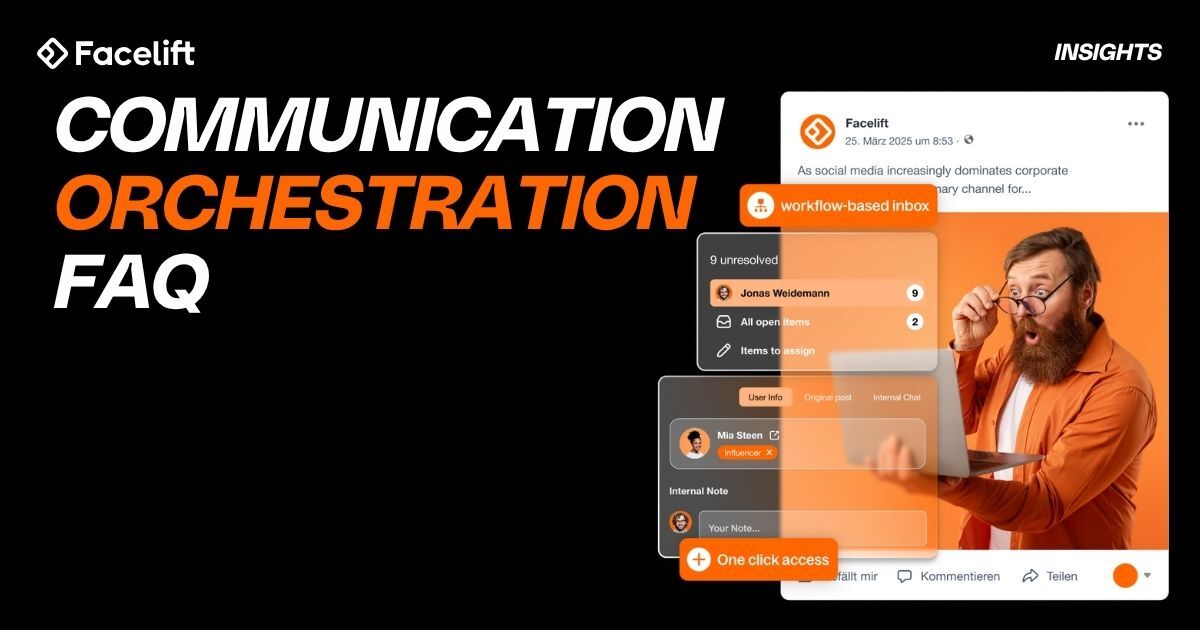The Facelift you love isn't going anywhere.
Social media has historically been Facelift's primary domain, and our customers have come to rely on our best-in-class social media solutions to creating, publishing, community management, and more.
Therefore, we want to reassure you that our latest release is not a product change. Communication Orchestration is a new category; it's a new methodology and philosophy that addresses the communication and content challenges of the present and future. It's a way to think about communication more strategically.
Facelift wants to help you play even bigger than before, but we also want things to stay familiar and comfortable.
Instead of removing things from the workflow you're used to, we're simply giving you more power and new possibilities.
The biggest change comes with the release of our updated Orchestrate tool. Orchestrate is still the calendar, planner, and content creation tool you're used to, and it will still do exactly what you rely on it for.
Soon, it will also help with campaign planning, task management, and communication across teams. The goal is to help organizations really orchestrate their content, rather than simply manage it.
FAQ for Communication Orchestration and Facelift Orchestrate
This FAQ has been written to explain common questions that we receive regarding how Facelift's shift away from being exclusively a social media tool, into a broader content and Communication Orchestration platform. It also answers common questions about the methodology of orchestration.
Q: What is Communication Orchestration?
A: Communication Orchestration is a methodology. It is a structured way of aligning communication efforts with strategic business goals across teams, campaigns, and channels. It ensures that every post, campaign, and conversation supports your larger objectives. You’ve already seen parts of this thinking in how Facelift helps you manage content, plan campaigns, and collaborate across teams. Communication Orchestration simply gives a name to what’s becoming essential for modern organizations. Read more about it in our definitive Communication Orchestration Manifesto.
Q: Is Communication Orchestration a new product?
A: No. Communication Orchestration is not a new product, software module, or platform.
It’s an approach to communication and content strategy that Facelift supports through the tools you already use.
That said, our updated Orchestrate makes it easier than ever to implement Communication Orchestration. With Orchestrate, you can visually map out strategic communication hierarchies, organize campaigns under strategic topics, and better align your teams from the start of planning through to execution.
Q: Does this change anything about how I currently use Facelift?
A: Not if you don't want it to. We're not removing any features from your current Facelift experience.
All your familiar workflows, tools, and processes stay exactly the same. Communication Orchestration simply gives you more options if and when you want to work more strategically.
Q: Do I need to learn anything new?
A: Not to continue using Facelift the way you always have. We are simply adding new, powerful features. But if you want to start applying Communication Orchestration principles, like better campaign alignment, topic management, or strategic planning, you’ll find new guidance, templates, and tools available inside Facelift.
Q: Why is Communication Orchestration important now?
A: Without a clear structure, organizations risk fragmented messaging, duplicated efforts, and missed strategic opportunities. But don't just take our word for it:
- Poor communication costs European businesses between €100–120 billion annually.
- Employees lose 14–16 hours per week clarifying miscommunication. That’s about 46 workdays per employee per year.
- Poor communication costs companies €13,000 per employee, per year in lost productivity.
- Only 23% of workers understand how their work connects to their company’s strategy.
- 75% of organizations say they struggle to execute their strategies due to communication breakdowns.
- Effective communication leads to a 25% increase in productivity, a 30% boost in customer satisfaction, and a 15% increase in conversion rates.
(Sources: Grammarly "2024 State of Business Communication," Deloitte "2025 Human Capital Trends," McKinsey 2024 studies, Axios 2024 reports.)
Q: I've heard about Social Media Orchestration before, how is Communication Orchestration different?
A: Social Media Orchestration is one component of Communication Orchestration. The latter focuses much more broadly across all channels of communication. We've written extensively about Social Media Orchestration in the past, and encourage you to read our seminal work on the subject: Origin to Orchestration - Paradigm Shift in Social Media Strategy. Furthermore, Social Media Orchestration is a great place to start if you'd like to begin orchestrating your content, but aren't yet ready for Communication Orchestration.
Q: Where can I learn more?
A: We’ll be sharing more resources over the coming weeks: articles, webinars, and templates to help you bring Communication Orchestration to life at your own pace. In the meantime, you can explore the updated Orchestrate module inside Facelift or speak with your Facelift customer success manager for personalized guidance.
Q: Is Communication Orchestration only for large companies?
A: No Communication Orchestration can work for anyone. While orchestration becomes even more valuable at larger scale, the principles apply just as powerfully to small and mid-sized organizations. Whether you have 10 people or 10,000, structuring your communication efforts around strategic goals just drives better results.
Q: Does Communication Orchestration include customer communication automation?
A: No. While customer communication automation could play a supporting role - it is not the essence of Communication Orchestration. Orchestration focuses on aligning communication efforts, both internal and external, planned and real-time, with the organization's business objectives. Automation tools may help deliver messages efficiently, but they are a tactical component. Orchestration is not simply about pushing messages, but rather clarifying and unifying campaigns, and conversations to contribute meaningfully to a single brand narrative.
Q: Is Communication Orchestration like Omnichannel?
A: Not exactly. Omnichannel focuses on the customer lifecycle and generating unified touchpoints that follow leads and customers across this cycle. Orchestration is focused more on the process of unifying content and communications strategy. However, omnichannel marketing is a very strong use case for Communication Orchestration, and companies who use omnichannel tactics would absolutely benefit from a better orchestrated approach! We wrote a more detailed article about this exact question here.
Q: What if I’m not ready for full orchestration yet?
A: That’s perfectly fine. Communication Orchestration is flexible and you can start small, by aligning a few campaigns or topics, and grow at your own pace. There’s no requirement to overhaul your workflows overnight. If you'd like to get started small with Social Media Orchestration, here's a guide you can use for that.
Q: How exactly does Orchestrate help with Communication Orchestration?
A: Orchestrate helps by giving you visual and referential tools to plan strategic communication hierarchies, organize topics and campaigns, and keep teams aligned. It's the workspace that makes orchestration easier to implement.
Conclusion
Once again, we want to assure you that our latest product update, the enhanced Orchestrate, will not change the way you work with Facelift unless you want it to. But with a whole new suite of powerful campaign planning and strategic tools at your disposal, we hope that you'll give them a try and discover how Communication Orchestration can benefit your entire company.


